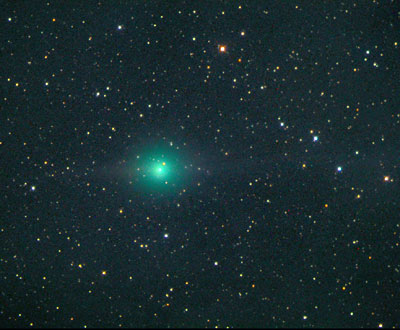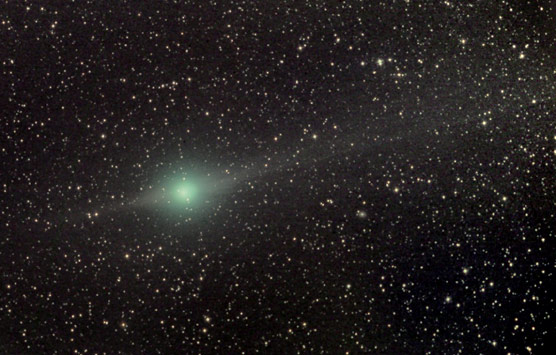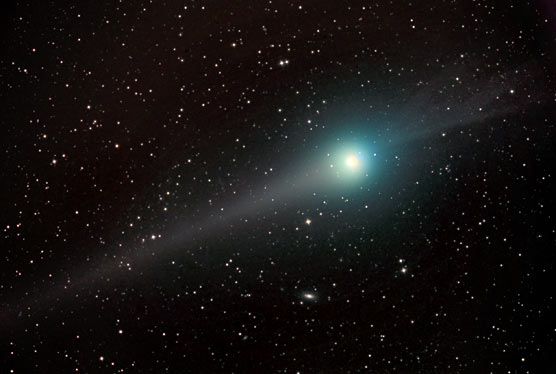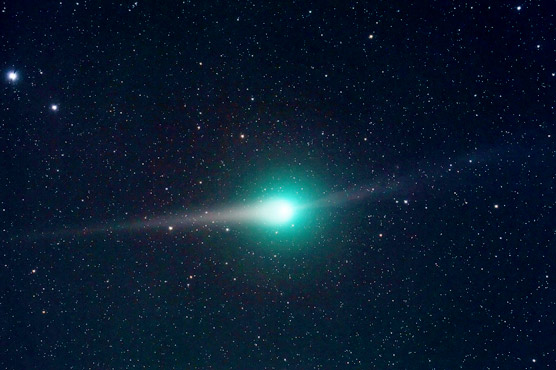There's a dim green comet departing Earth's vicinity, and even though it passed its peak in late February, you may still be able to spot it with binoculars — even through some light pollution. But you'll have to know exactly where to look.
The comet, C/2007 N3 (Lulin), was discovered at Lulin Observatory in Taiwan in July 2007. In telescopes and low-light images, it displayed both a dim gas tail and a brighter dust-spike antitail. They pointed in nearly opposite directions for a couple of months, but at the comet's opposition in late February the gas tail swung around (from Earth's viewpoint) to align with the dust tail. Both are now pointing in the direction away from the Sun.
The comet peaked in brightness In the last several of February at about magnitude 5.0. As of mid-March it should be magnitude 6 or 7 and fading.
For a finder chart, click the appropriate date range below (printable PDF format):
Jan. 1 – Feb. 14
Feb. 13 – Mar. 2
Mar. 3 – Mar. 20
Mar. 14 – May 1
Below is a calendar of the comet's doings past, present, and future. And if celestial coordinates are what you want, here's an ephemeris.
JANUARY: Pre-dawn, and Brightening
The comet spent January getting higher and brighter in the morning sky as it moved across Libra. The beginning of January found it glowing at 7th magnitude, not quite as bright as predicted. It was at perihelion (closest approach to the Sun) on January 10th, at a solar distance of 1.2 a.u. (181 million km). But after perihelion Lulin continued brightening as its diminishing distance from Earth more than compensated for its moving away from the Sun.
January 17: Mariano Ribas in Argentina writes: "Despite Moon interference, the comet right now is an easy target for amateur telescopes of 10 to 20 centimeters (4 to 8 inches) and big binoculars here in Buenos Aires, a city with strong light pollution (limiting magnitude about 4). Today, 1½ hours before sunrise, I saw the comet again and estimated its visual magnitude about 7.0, with a coma 3′ in diameter and moderately condensed (DC: 5/6). But no signs of tail."

Comet Lulin was showing mere ghosts of a tail and an antitail on January 19, 2009, when Michael Jaeger took this image from Austria. He used an 8-inch f/2.8 astrographic camera for exposures through LRGB filters totaling 10 minutes.
January 21: "Quite visible in 10x50 binocs in spite of the crescent Moon being close," reports Amar Sharma in Bangalore, India. "20x80 binocs gave a better view as a fuzzy globular, and the 8-inch scope did reveal a condensed fuzzy coma ~4–5 arcminutes in diameter."
January 22: Still only about mag 6.8 or 7.0 according to reports, about 1 magnitude below predictions.
January 25: "I picked it up instantly with 10x30 binoculars this morning," says S&T's Tony Flanders, who was under a dark country sky. "It seemed comparable in overall brightness to M53 [a 7.7-magnitude globular cluster in Coma], but bigger and with lower surface brightness. In a 12.5-inch Dob at 227×, it was a very bright circular blob getting continuously brighter toward the center. I couldn't make out a stellar nucleus. I thought I saw an antitail, but it might well have been my imagination."
January 30: On the other hand, in the light-polluted suburb of Arlington, Mass., this morning, Flanders could not detect the comet with 10×30 binoculars. A 70mm refractor showed it dimly. Light pollution makes a big difference.
January 31: "Comet Lulin is a very easy target for small telescopes and binoculars in Buenos Aires´s sky, despite our light pollution (naked-eye limiting magnitude 4.5)", writes Mariano Ribas. "With the Sun still 18° below the horizon, here in Buenos Aires the comet appears 50° over the east horizon." He estimated its visual magnitude at 6.5, "a half magnitude better than 10 days ago," using a 90mm refractor at 25×. "The coma looks asymmetrical, oval in shape, and moderately condensed (DC: 5). Still, I can´t see any of the tail (because our light pollution)."
Also take a look at Jeremy Perez's visual sketch here of the comet as seen in an 8-inch scope at 120×.

Comet Lulin on February 2nd, glowing at magnitude 6.5 with tail and antitail. Click image for larger view.
Paolo Candy
.
FEBRUARY: Peak Brightness, Peak Speed
As Comet Lulin nears Earth, it brightens and its speed across the sky increases.
February 4: "Today we were lucky enough to capture an intriguing phenomenon," write Ernesto Guido, Giovanni Sostero and Paul Camilleri. "In our images of comet Lulin, clearly visible is a nice disconnection event (DE) in the plasma tail. The DE indicates that the comet recently passed through a disturbance in the magnetic field carried by the solar wind; that destroyed the original plasma tail, creating a new one. The separation of the two ion tails is visible in our image as a kind of elongated and diffuse knot along the plasma tail." See the images on their blogsite.
February 6: This morning the comet passed close by the wide binocular double star Alpha Librae; see gorgeous photos.
February 7: Its reported magnitude is now 6.1.
After moving about 1° per day at the start of February, by February 11th Lulin was creeping westward at 2° per day as it crossed into Virgo. On the night of February 15–16 it passed 3° north of Spica, while now traveling 3° per day.
The sky is dark and moonless again from about February 16th to the 28th. And the good observing times for Lulin are now more convenient: midnight or late evening rather than early morning.
February 17: Mariano Ribas writes from Buenos Aires, "I observed comet Lulin again, this time with my Orion 90mm refractor (25×). We still have the Moon causing some interference, but despite of its glare, the comet is a very bright object in my telescope. Using the "in-out" method and two stars of mag. 5.7 and 5.3, I estimated Lulin´s magnitude at 5.6 . Its coma is clearly bigger (8–10 arcminutes) and more concentrated (DC: 6) than just five days ago. I could not see any of its tail or antitail.
"If that brightening continues in the next days, comet Lulin will reach magnitude 5.0 or even better during its closest approach on February 24th. A good comet to celebrate the International Year of Astronomy!"
February 18: Alan MacRobert in the Boston suburbs: "It was easy and obvious to sweep up with 10×50 binoculars, looking out my bathroom window at 2 a.m. It even had the flying-saucer shape familiar from photos. Gray with barely a hint of green. The stubby antitail was fairly easy, the other tail not so much. This was with the binoculars held very steady with their homemade image stabilization."

"The Sword Comet — I have named it so!" writes Paolo Candy of the Cimini Astronomical Observatory & Planetarium in Italy. As of 0:30 UT February 20th, when Candy took this picture, the dust antitail (left) had grown in prominence to quite outdo the gas tail (right), which points away from the Sun. The small spiral galaxy below the comet is NGC 4546.
Candy used a 10-inch f/3 Baker-Schmidt Zen astrograph, and an SBIG STL 6303E camera, for L, R, G, and B exposures 3, 1, 1, and 2 minutes long, respectively.
February 20: Here's a NASA press release on the Swift satellite's observations of the comet in X-rays and the ultraviolet.
February 22: Magnitude 5.3 now by various reports.

The comet on the night of February 20-21, imaged by Conrad Pope. The gas tail (right) is glowing blue with the light of fluorescing carbon monoxide ions, the aquamarine-green color comes from fluorescing CN and C2 molecules, and the whiter antitail is dust reflecting sunlight.
February 23: In a moonless sky and near its peak brightness, Comet Lulin passed 2° south-southwest of Saturn.
"It's difficult to explain how beautiful the view of Lulin was through the [25×100] binoculars — something I could have gone staring at all through the night!" writes Amar Sharma of the Bangalore Astronomical Society. "I made this observation at our star party in the pristine forests of Western Ghats, latitude +13°. It displayed an extremely bright and distinct tapering dust anti-tail for around half the [3.5°] field of view.... I could not see the primary ion tail, maybe it was too tenuous and faint.
"The coma was a minimum of 15 arcminutes diameter. With naked eyes, the large coma appeared as bright as a 5.5 mag star. Easily seen and appeared elongated and fuzzy. Indeed an amazing comet to remember!"
February 24: Lulin was closest to Earth: 0.41 a.u. (61 million km, or 38 million miles), though it's just about as close for a few days before and after.
February 25:: The comet today went through opposition, nearly 180° from the Sun in our sky. So we were looking almost exactly down the length of the blue gas tail. After opposition the gas tail will appear to reverse sides with respect to the comet's head and should more or less align with the antitail.
For instance: play amazing movie of images taken by Filipe Alves of Portugal on the morning of February 25th right around opposition. The movie shows un-cometlike curlicues of the gas tail appearing to leave the comet at right angles to the dust tail from our perspective.
In late February the comet was speeding across the sky at 5° per day — about 1 arcsecond every 5 seconds of time, enough to show obvious motion during a short telescopic observing session. The evening of February 27th found it at about magnitude 5.5 as it passed within 1° of Regulus.
Weird Orbital Geometry
Strangely (as you may have noticed on the detailed PDF charts), this comet is traveling almost exactly along the ecliptic — backward! Could this really be just be a coincidence? The comet's nearly parabolic orbit indicates that it has never much interacted with the planets at all. Yet its orbital inclination is 178.4°, meaning that it's orbiting in the opposite direction from the planets just 1.6° from the ecliptic plane. (Manipulable 3-D orbit diagram).
Tails and Antitails
Because the comet stays nearly on the ecliptic, its tail (which points away from the Sun) aligns with the ecliptic and with the comet's own direction of motion across the sky. This is indicated by the direction the tail is pointed on the comet symbols on the PDF finder charts linked to above.
Moreover, because Earth remains in the comet's own orbital plane, we see the comet with a very thin tail and an antitail, a spike pointing in almost the opposite direction from the main tail. Why? In three dimensions a comet's dust tail is often wide but it's always thin, like a paper cutout, confined to the comet's orbital plane. When we are in or near this plane, we can sometimes see parts of the wide, thin dust tail on opposite sides of the comet's head. We pass through most comets' orbital planes briefly. But this time, the situation will last and last.
And indeed, as early as January 7th Lulin did have an antitail, as shown in this image taken by Karzaman Ahmad in Malaysia with a 20-inch scope (image courtesy Spaceweather.com.) Here's another image, from Ernesto Guido, Giovanni Sostero and Paul Camilleri, taken January 8th. Here's a photo gallery of more.
A comet's blue and green gas tail, on the other hand, always points nearly in a straight line away from the Sun in space. Cometary gas is blown directly away from the Sun at high speed by the solar wind.
MARCH: Following Lulin Out
Comet Lulin crossed from Leo into Cancer at the beginning of March. Having passed opposition, it is now best seen in the evening hours as it continues speeding westward. But observers have to contend with moonlight from about March 1st through 11th.
The night of March 5th found the 6th-magnitude comet within 2° of both Delta (?) Cancri and the Beehive Cluster, M44. But the Moon was also nearby.
Another conjunction occured on March 16th when the comet, now around 7th magnitude but in a dark sky (and best seen early in the evening), passed within 1° of Delta Geminorum.
By March 17th the comet was two-tailed again: see sketch by Bill Weir.
As Comet Lulin recedes, its passage across our sky slows. Indeed, from the end of March to the end of May (when Lulin may have faded to 11th magnitude) it will stay within a narrow, 3° strip of sky bounded by Epsilon (?), Mu (?), and 36 Geminorum. By May's end it will be lost in the afterglow of sunset.
Comet Lulin won’t return again to the inner solar system for more than a thousand years, if ever.
Cooperative Discovery
Comet C/2007 N3 (Lulin) was discovered by Quanzhi Ye, a student (age 19) at Sun Yat-sen University in mainland China, as an apparently asteroidal object on images taken by Chi Sheng Lin (National Central University, Taiwan) with a 16-inch telescope at Lulin Observatory in Taiwan on the night of July 11, 2007. A week later, confirming images revealed the telltale presence of a coma. In China and Taiwan, the comet has been hailed as the "Comet of Cooperation."
Lulin was one of 223 comet discoveries on images taken from the ground and in space in 2007, an all-time record.
For a gallery of images and a light curve, check the Comet Lulin page on Seiichi Yoshida's Weekly Information about Bright Comets. And don't miss the gallery of images at SpaceWeather.com.
To find when the Moon rises and sets at your site on any date, make sure that your location and current time zone are in our online almanac; uncheck the Daylight Saving Time box if necessary.
Postscript: What Happened to Comet Boethin?
By Greg Bryant
Another comet was expected to be visible in binoculars around this time: Periodic Comet 85P/Boethin. Discovered in 1975 by the late Rev. Leo Boethin (1912–98) in the Phillipines, this comet orbits the Sun every 11 years. Or at least it used to.
Comet Boethin was recovered in 1985 and was predicted to brighten to no more than 12th magnitude during the winter of 1985–86 (when comet watchers were enjoying the buzz of Halley). However, it managed to surprise, reaching 7th magnitude in January 1986!
Did this outburst disrupt it completely? Comet Boethin was on track to return in 1997, but the poor circumstances of that return meant it could not be sighted. Nevertheless, astronomers decided in 2005 to redirect the Deep Impact spacecraft (now renamed the EPOXI mission) to study this comet, as its orbital path was ideal for the spacecraft.
In 2007 observers around the world and in space started searching for Comet Boethin, but to no avail. Not even a fragment has been found. Perhaps some tiny faint bit will be picked up by patrol telescopes in early 2009. But as of December 1, 2008, there was still no trace of it to 20th magnitude.
Fortunately, the EPOXI mission has now been redirected to the short-period comet 103P/Hartley 2. This one has been seen at four apparitions, so its orbit is secure.
This is not the first time that a periodic comet has been seen on two returns only to be lost. One example in the last century was 34D/Gale, discovered in 1927 from the inner suburbs of Sydney, Australia. It was recovered in 1938 but never seen again. Like Boethin, it too, coincidentally, had a period of 11 years.
 0
0
Comments
You must be logged in to post a comment.